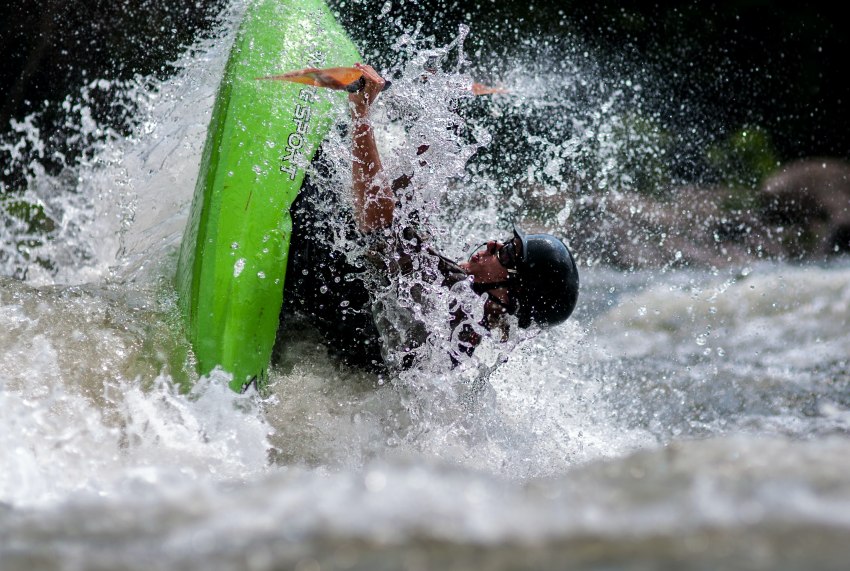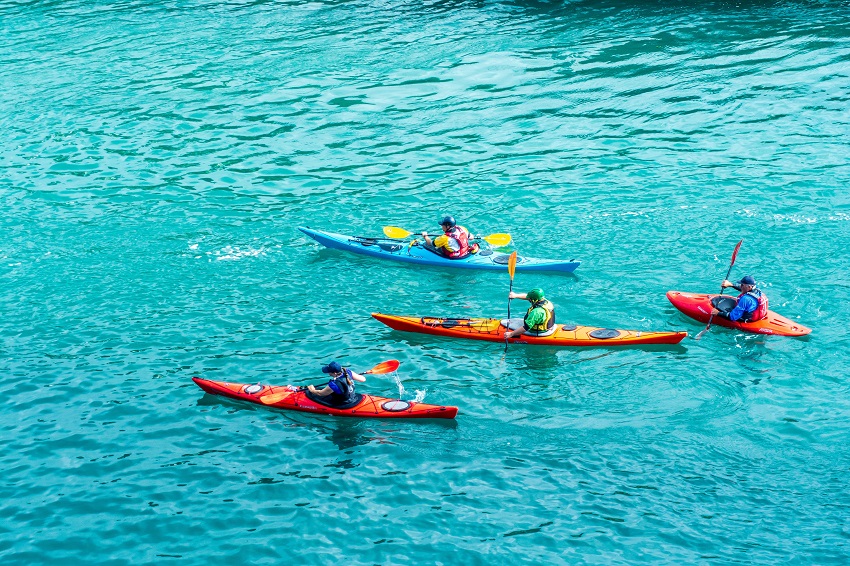In this guide we discuss different sizes of kayak paddles, give tips to help you select the right paddle length and consider other important paddle factors.

When you or a fellow paddler capsizes, you need to act quickly and safely to perform a rescue, get them back into their kayak, and back on their way.
But without knowledge and practice, you might end up making things worse.
After years of paddling and leading tourist groups, I can’t stress the importance of good rescue techniques enough. Practice is key. Get out on the water on calm days, fall in the water and learn to rescue a kayak.
Here’s my advice on how to rescue kayaks and help to keep yourself and other paddlers safe on the water.
Prioritize Your Own Safety

Many rescues start out as a simple scenario with a single casualty in the water. However, they can quickly turn into a far more serious situation because the rescuer didn’t prioritize their own safety.
Before you paddle in to help your casualty, have a quick check around you and make sure that you’re not going to become an extra casualty. Usually, this happens in more challenging environments such as rivers, or in strong wind.
The order of priority in any rescue situation should be:
- Yourself
- The remainder of your group – the other paddlers on the water
- The victim
- Any equipment
Once you have established that you can keep yourself safe, make sure the other paddlers on the water are also not going to become victims.
When you know you’re not going to get more victims in the water, you can start getting your victim out of the water.
Equipment is important, especially if you’re out in the midst of the sea, but it’s useless if you haven’t rescued the victim.
Rescuing a Sit-on-top Kayak
Before you can get yourself or a fellow kayaker back into their kayak, you need to right and empty the kayak. If you’re the paddler in the water, you need to turn your sit-on-top kayak back over and climb back onboard. Climb up the side of your overturned sit-on-top and push down on the nearside, being careful not to bring the kayak down onto your own head.
As the rescuer, paddle up alongside the upturned kayak and push down on the near side. Keep your hands flat and avoid any possible entrapments. As the kayak turns over, guide it down gently to the water avoiding yourself and the victim in the water.
Rescuing a Closed Cockpit Kayaker in Deep Water
Rescuing a sit-on-top is relatively straightforward, with the flat hull design purpose-built to shed water.
A sit-in kayak, however, will fill with water when it capsizes, making it harder to rescue.
Before you head out on the water, make sure the kayak has airbags or sealed bulkheads to prevent the water from flooding the entire kayak.
Deep water kayak rescue technique has come on a long way in recent years, with changes made to avoid over-straining the rescuer’s back or arms.
The first thing you want to do is right the capsized kayak, no matter how counterintuitive this might seem. The easiest way to do this is the same as righting a sit-on-top, by paddling alongside the kayak and pushing down on the nearside until the kayak rights.
Then, maneuver yourself (or the flooded kayak) so the nose is alongside you in a T-shape, then follow these steps.
- Have your casualty hold the nose of your kayak so that you know where they are at all times. Stow your paddles securely (or get your swimmer to hold them) so they don’t float away.
- Reach underneath the nose of the kayak with your nearside hand and grasp the keel line – this is easier with kayaks with a sharp V-shaped hull.
- With your farside hand, hold the top of the kayak on the side closest to you.
- Your near hand will pull and your far hand will push. This rolls the kayak over and away from you. Use the momentum to roll the nose up onto your cockpit.
- Hold the kayak on its side as the water drains out of the cockpit. Tip slightly further when necessary and when the kayak is empty enough that this doesn’t strain you.
- If there is any water remaining (often the case in recreational or creek kayaks) turn the kayak all the way over. If the kayak does not have adequate airbags, you may have to maneuver it so the cockpit is right over your deck and rock gently side-to-side to empty the water fully.
- Roll the kayak away from you until upright and gently slide it back into the water, avoiding your casualty, then follow the steps further down to get the kayaker back into their kayak.
How to Get a Kayaker Back into Their Kayak: The Heel Hook Technique
Emptying the kayak is just one part of the process, but often you find that rescuers stop their practice there. Out on the water, I’ve seen more people flood their kayaks while getting a swimmer back into their boat than I can count.
Old school techniques had the swimmer going between the boats or wrestling themselves back into the kayak in potentially dangerous ways.
This new technique, called the heel hook, will get your swimmer back into their kayak quickly and safely.
- Line up the empty kayak alongside yours but facing in the opposite direction. Take the paddles from your swimmer and rest them across both cockpits. Reach over and hold the kayak on both sides of the cockpit.
- Have your swimmer move themselves to the far side of their kayak – use deck lines on touring kayaks to keep them in contact and avoid them drifting off.
- The swimmer should turn their body to face the same way as their kayak and lay back in the water.
- The swimmer now reaches up with the hand furthest from the kayak and holds the cockpit. They then hook their far-side leg into the cockpit.
- With their leg in the cockpit, the swimmer can now roll themselves up and into the kayak while the rescuer holds both kayaks level. Often people will end up facing backwards in their kayak, so allow them to turn around and sit down.
- Once back into the kayak, the swimmer can sort out their gear and get themselves comfortable while the rescuer holds them stable.
Bow Presentation
The best kind of rescue is one that doesn’t see the kayaker exiting their kayak at all. If you see a fellow kayaker capsize – and you’re quick – you can get them back upright without them having to pop their spray skirt and swim at all.
This technique, called bow presentation, is a pre-curser to a kayak roll. It is often used as part of the practice, but it’s a skill that can be used in peer kayaking to avoid hassle and added risk.
- The paddler of the upturned kayak stays in their kayak, leans forwards and reaches under their seat. They should hit the underside of their kayak three times with their hands to attract the attention of those around them and then start slowly moving their hands forwards and backwards, ready to grab the rescuer’s bow.
- The rescuer paddles alongside the upturned kayak to form a T-shape, with their bow presented to the capsized kayaker’s hand.
- The capsized kayaker holds the bow of the rescuer’s kayak with both hands and uses it to support themselves as they right their kayak. To avoid overstraining, try to bring your head up last and use your hips and knee to drive your kayak upright.
Self Rescue: How To Rescue a Kayak If You Paddle Alone
If you go kayaking alone, you need to know how to self-rescue.
Many solo kayakers at a recreational level will paddle sit-on-top kayaks, which are safe and easy to rescue on your own – as shown above.
But if you paddle a sit-in kayak, things can be a bit more difficult.
Swim to Shore
If you’re anywhere close to the shore – or on a river – your best option might be to swim your kayak to the beach and empty it there.
Turn your kayak upright and stow your paddle in the cockpit, then either push and swim or tow your kayak using a sling to get to the beach.
Have a look at the river rescue techniques further down for how to tow a kayak safely.
Use a Paddle Float
The easiest way to self-rescue in a touring or sea kayak is to use a paddle float.
- Start by turning your kayak upright. It will be full of water but your bulkheads should stop it from flooding completely.
- Hook your nearside leg into the kayak to prevent it from drifting away and attach your paddle float to your kayak paddle.
- Once your float is attached, tuck the other end of the paddle under the deck lines just ahead of the cockpit. This allows the paddle and paddle float to act like an outrigger.
- Climb back into the kayak using the heel hook technique. Remember, your paddle is supportive, but not as much as a fellow kayaker, so being slick is recommended here.
- Get the water out of your cockpit using a bilge pump or bailer, then sponge out the final drops.
The Scramble
This technique is far less dignified, but if you don’t have a paddle float, it may be your only option.
The scramble is exactly what it sounds like. It can be easy to re-capsize your kayak while performing this rescue.
- Turn your kayak upright and stow your paddle securely under the deck lines or in the cockpit.
- Place your hands on the rear coaming of the cockpit and roll yourself onto the back deck of your kayak. Try to balance your weight across the kayak to avoid re-capsizing.
- Shimmy your way forwards until you can drop yourself onto your kayak seat.
- Empty your kayak using a bilge pump or bailer, then sponge out the final drops.
Roll Your Kayak
Perhaps the ultimate technique in self-rescue is the kayak roll.
If you can capsize and right yourself without coming out of your kayak, then you don’t have to worry about everything else.
Of course, even the best roll is never totally bombproof, so make sure you practice other techniques too.
The kayak roll involves using your paddle in conjunction with your hips and knee to drive your kayak back upright. There are multiple techniques that suit different kayaks and environments, far too many to cover here.
The kayak roll takes practice and many kayakers find it the most frustrating skill to learn, but it is also one of the most useful.
How to Rescue a Kayaker on a River
No matter how rough the conditions, in open water you can generally follow the same steps to perform a rescue. On a river though, swift currents can quickly see you taken downstream.
What’s more, you often have to contend with the swimmer, their kayak, and often their paddle becoming separated. This is where the list of priorities becomes even more important.
Simple Safety Steps as a Swimmer
River kayaking is my jam. Part of learning to kayak rivers is learning to swim on them – even if you don’t mean to.
Here are a few safety tips for a swimmer to avoid making things worse than they already are.
- Let go of your kayak. Your kayak is going to be full of water, and your priority is to try to swim yourself to the river bank. You’re never going to do that if you are holding onto your kayak.
- Keep hold of your paddle though. Your rescuer already has plenty to do, so if you can hold your paddle then that’s great. On narrower rivers, I will often throw my paddle towards the bank and swim myself. Alternatively, you can kick with your feet and paddle yourself through the water.
- Keep your feet up. You don’t know what’s on the river bed and trapping your foot in rocks or roots can have serious consequences. Don’t be tempted to walk out of the river until you’re right by the shore in calmer water.
Defensive and Aggressive Swimming
There are two swimming positions you should familiarise yourself with as a river kayaker that can help you avoid injury and get yourself safely to the side of the river.
Defensive Swimming
Defensive swimming is used to protect yourself as you go down rapids. Lay on your back with your feet downstream and push your hips towards the sky – lifting your butt away from rocks. Use your feet to push off rocks and swim with your arms to move around the river if you need to.
Aggressive Swimming
When there’s an opportunity to swim to the shore, roll over onto your front and swim aggressively for the shore. You should still face upstream to keep your feet as protection from rocks. This also lets you swim across the current in a ferry glide position, as you would paddle across the current.
Shunting a Kayak to the Shore
As the rescuer, your priority is the kayaker. Don’t abandon them to their fate just to rescue their kayak, but once they are safe on the shore – or being looked after by another competent kayaker – you can rescue their kayak.
Unless you’re on a wide and slow-moving river, you don’t want to perform your rescue in the middle of the flow. Instead, you want to get that kayak to the bank where you can empty it using the drain bung. You can do this by shunting the kayak with your nose and pushing it with your hands.
Start by turning the kayak upright. Kayaks float better upright, it’s just a fact.
A river kayak with adequate airbags in the bow and stern should float well enough to shunt. But if it’s lacking bags one end – or the whole kayak – will dive underwater and make this process harder.
Empty a little water if you need to and then shunt the kayak into an eddy by the shore and proceed to empty it.
Towing a Kayak to the Shore
If shunting isn’t working, you can always tow the kayak. The important thing with towing a kayak – especially on a river – is to make sure you can always release your towing system and keep yourself safe.
You should have a sling – or tape – in your PFD pocket that you can attach to one end of the kayak. You can either tow your kayak with a closed loop or an open tape with the following methods.
- For closed loop towing, place the loop over one shoulder – your downstream shoulder as you paddle across the flow – and paddle the kayak into the side. If you need to release the system, just allow the tape to fall off your arm.
- With open tape, most rescuers will choose to wrap the tape once around their paddle and hold it under their hand. This makes paddling a little more challenging but does give you a quick release system that’s fast to set and release. Don’t be tempted to wrap the sling too many times as it can work itself into a knot and not release. Trust me, I’ve been stuck in a hole with a tape that wouldn’t release and I do not recommend it.
Get Out And Practice
Everyone falls in. Heck, I’ve fallen in so many times that I just accept it as part of kayaking. The best thing you can do to keep yourself and your buddies safe is to get out and practice rescuing kayaks and swimmers.
Try out different techniques. Find a warm day and go swimming about in the water and emptying kayaks. Once you’re confident in your abilities, test them out in slightly more challenging environments. Remember, very few kayakers fall in on flat calm days, so it’s good to practice these skills in a ‘real world’ style.









